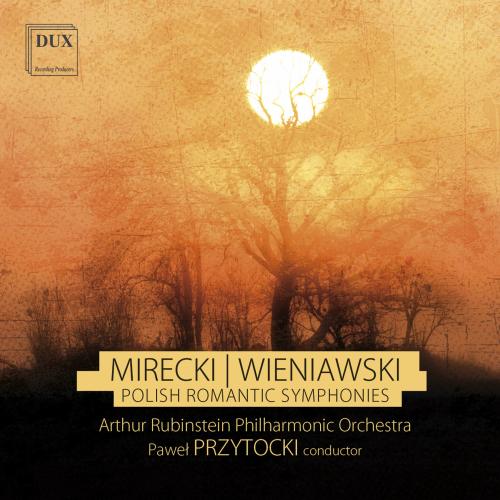
Polish Romantic Symphonies: Mirecki, Wieniawski Arthur Rubinstein Philharmonic Orchestra & Paweł Przytocki
Album Info
Album Veröffentlichung:
2022
HRA-Veröffentlichung:
12.05.2023
Label: DUX Recording Producers
Genre: Classical
Subgenre: Orchestral
Interpret: Arthur Rubinstein Philharmonic Orchestra & Paweł Przytocki
Komponist: Franciszek Mirecki (1791-1862)
Das Album enthält Albumcover Booklet (PDF)
- Franciszek Mirecki (1791 - 1862): Symphony in C minor:
- 1 Mirecki: Symphony in C minor: Allegro vivace con brio 10:48
- 2 Mirecki: Symphony in C minor: Adagio non tanto 08:18
- 3 Mirecki: Symphony in C minor: Scherzo. Vivo assai 05:37
- 4 Mirecki: Symphony in C minor: Ultimo tempo. Vivace molto 09:00
- Józef Wieniawski (1837 - 1912): Symphony in D major, Op. 49:
- 5 Wieniawski: Symphony in D major, Op. 49: Allegro con spirito, un poco pastorale 11:01
- 6 Wieniawski: Symphony in D major, Op. 49: Andante molto cantabile 08:34
- 7 Wieniawski: Symphony in D major, Op. 49: Scherzo 05:00
- 8 Wieniawski: Symphony in D major, Op. 49: Finale. Allegro energico e risoluto 07:55
Info zu Polish Romantic Symphonies: Mirecki, Wieniawski
Diese Neuveröffentlichung von DUX präsentiert zwei Sinfonien aus dem 19. Jahrhundert von zwei polnischen Komponisten, die zwei verschiedenen Generationen angehören und bisher fast unbekannt waren.
Die Symphonie in c-Moll von Mirecki war sein einziges symphonisches Werk. Sie wurde in einer handschriftlichen Abschrift in der Hauptbibliothek der Adam-Mickiewicz-Universität in Posen aufbewahrt und 1972 vom polnischen Musikverlag herausgegeben, allerdings mit einem Kommentar, der auf den geringen Wert des Werks hinweist.
Im 19. Jahrhundert gab es nur wenige Komponisten, die sowohl in der Sinfonie als auch auf der Bühne erfolgreich waren. Mireckis Sinfonie weist einige Züge des Opernstils auf, aber das ist kein Makel. Es handelt sich um ein groß angelegtes Werk mit großen Proportionen, das auf der Technik der Entwicklung des Materials basiert, dicht, aber mit Kenntnis der Instrumentation, stark emotional, voller Leidenschaft, aber nicht sentimental, sondern sachlich.
Mireckis Sinfonie eröffnet die Ära der "klassizistischen Romantik" in der polnischen Musik und fügt sich in die Ästhetik der europäischen Sinfonie der zweiten Hälfte des 19. Jahrhunderts ein, die die expressiven und technischen Entdeckungen der Romantik mit der Beethoven'schen Disziplin und der Tendenz zur Monumentalität verband. Ihre Beziehungen zu späteren Werken herausragender Sinfoniker beweisen, dass das Werk zur Hauptlinie der Sinfonie im 19.
Jozef Wieniawski gehörte zur Generation von Johannes Brahms, Camille Saint-Saens, Max Bruch, Mily Balakirev, Pjotr Tschaikowski und Antonín Dvorak. Seine Sinfonie D-Dur op. 49, die 1890 in Brüssel veröffentlicht wurde, ist eines seiner letzten Werke. Über ihre Aufführung liegen uns bisher keine Informationen vor.
Der Stil von Wieniawskis Sinfonie entspricht der Zeit und dem Ort, an dem sie entstanden ist. Sie steht dem Paris des ausgehenden 19. Jahrhunderts nahe, aber es ist das Paris von Cesar Franck und Ernest Chausson, nicht von Claude Debussy. Es ist ein poetisches Werk, das Bilder hervorzurufen vermag, neben denen Mireckis vierzig Jahre zuvor entstandene c-Moll-Sinfonie wie eine fast abstrakte Quelle reiner Energie wirkt.
Arthur Rubinstein Philharmonic Orchestra
Pawel Przytocki, Dirigent
Paweł Przytocki
was appointed Artistic Director of the Arthur Rubinstein Philharmonic.
Born in Krosno, Mr. Przytocki graduated from Prof. Jerzy Katlewicz’s conducting class at the Academy of Music in Cracow in 1985. In the years 1986–1987, he received a scholarship from the Bachakademie Stuttgart, where he attended Prof. Helmuth Rilling’s masterclasses.
As early as in 1983, Paweł Przytocki cooperated with the Cracow Philharmonic, and in 1987 with the Grand Theater in Łódź. In the years 1988–1991, he served as conductor and Artistic Director of the Baltic Philharmonic in Gdańsk, from 1995 to 1997, he was Artistic Director of the Arthur Rubinstein Philharmonic, and in 2008–2012 he was Managing and Artistic Director of the Karol Szymanowski Philharmonic in Cracow
In 2005, Paweł Przytocki started cooperation with the Grand Theater – National Opera House in Warsaw. In the 2005/2006 season, he premiered Aram Khachaturian’s “Spartacus” and led the orchestra in Piotr Tchaikovsky’s “Eugene Onegin,” Giuseppe Verdi’s “La Traviata, as well as Giacomo Puccini’s “La bohème.” In the 2006/2007 season, he conducted a premiere of “Eugene Onegin” choreographed by John Cranko.
Paweł Przytocki has worked with most philharmonic orchestras in Poland, as well as many symphony and chamber orchestras abroad, including the Budapest Concert Orchestra, Orchestra Sinfonika de Xalapa, Real Filharmonia de Galicia, Capella Istropolitana in Bratislava, Neue Philharmonie Westfalen, Philharmonisches Staatsorchester Halle, Bilkent Symphony Orchestra in Ankara, Janáček Philharmonic Orchestra in Ostrava, Slovak Philharmonic in Bratislava, National Symphony Orchestra of Ukraine in Kiev, National Philharmonic in Santiago, National Philharmonic in Zagreb, New Haifa Symphony Orchestra, Buffalo Philharmonic Orchestra, Orquesta Filarmonica de Bogota, Jerusalem Symphony Orchestra, Staatsorchester Rheinische Philharmonie Koblenz, and Jenaer Philharmonie.
Przytocki has led Polish orchestras in Germany, Austria, Switzerland, Belgium, the Netherlands, France, and Spain, and regularly appears at international music festivals, including the Athens Festival (1987), Musikfest Stuttgart (1988), Flanders Festival (1989), La Chaise-Dieu Festival (1996), Kissinger Sommer (1998), Bratislava Musik Festival (1999), Augsburger Mozartsommer (2000), Prague Spring (2001), and Wratislavia Cantans (2005).
Paweł Przytocki has also appeared at many prestigious venues around Europe, such as Musikverein in Vienna, Konzerthaus in Berlin, Palais des Beaux-Arts in Brussels, Teatro Municipal in Santiago, Théâtre du Châtelet in Paris, Musikhalle in Hamburg, and Beethovenhalle in Bonn.
Przytocki has made several archival recordings for the Polish Radio and Television, and recorded albums for the labels DUX, Aurophon, and Point Classics. His rendition of Rachmaninoff’s Symphony no. 1 was hailed by the American music magazine “La Folia” as an example of a rare level of intensity and devotion in music (along with Carlos Kleiber’s Beethoven Fifth and Sviatoslav Richter’s Appasionata).
Since 2007, Paweł Przytocki has worked at the Conducting Department of the Academy of Music in Cracow, where he runs a conducting class.
In February 2017, Przytocki led the Arthur Rubinstein Philharmonic Orchestra in a performance at the Golden Hall of the renowned Musikverein in Vienna. The great success of that concert and the enthusiastic applause of the international audience provided inspiration for his appointment as Artistic Director of the Philharmonic.
Booklet für Polish Romantic Symphonies: Mirecki, Wieniawski











